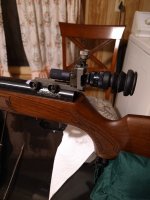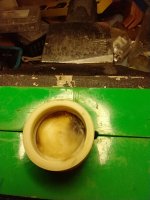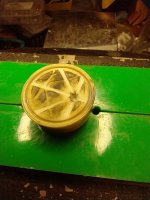I just had the most remarkable experience with my .22 HW90. I have been experimenting with power levels and different barrels. A couple of days ago I got around to installing a Vortek 30mm Vacuseal piston seal, and tried some shot strings with different pellets and gas ram bar levels. Here's a very rough table, I tried only a couple of pellets of each type. The power levels are ludicrous. Crosman Premieres now breeze through 3/4" hardwood plywood. At first I thought it must be dieseling, but later ran about 100 pellets through the gun and am getting the same general results. Also I used very little lube with the new seal.
Power is about the same as the stock seal, up to 19 bar. Above that the Vacuseal provides an increase.
The HW90 is a mystery. It's a big, super strong gun. It has huge piston swept area, and can provide tremendous piston pressure. It has a long barrel with robust linkage. So why are the power levels less than other magnums? Why does the power curve peak at 21FPE @ 19 bar? It can't be friction, the piston design is straightforward and conventional.
My best guess is that ram pressure above 19 bar distorts the stock seal. This could allow gas to blow past it, lowering power. Alternatively it could cause the seal to bind against the cylinder wall, increasing friction, and again lowering power. I checked the stock seal for damage and wear. The face has the typical star pattern discoloration, but seems sound. The rim of the stock seal doesn't show any frictional wear. So I opt for the blow-by explanation. The HW90 simply overpowers the stock seal. Variation in seals might also explain why some reviews put the RX2 at 24 FPE, while others put the HW90 at 21 FPE. Beeman might have specified a different seal.
It's nice to know that a HW90 can put out 36 foot-lbs, but the real issue is the cocking effort. My zone of comfort is at 19 bar. For general use I set the gun back to 19 bar, where it get a consistent and accurate 800 FPS and 21 FPE. Also the muzzle crack at 26 bar is ridiculous, approaching a 22 rimfire.
Future projects include running some shot strings with my .25 barrel. I just ordered a carbine barrel (410mm long) in .22 from AoA and a couple more Vortek 30 seals. I want to see if the shorter barrel affects power. Yes, I know it's going to be a real bear to cock at 26 bar. Oh well, It's for the science. LOL. My goal is to get the lightest, most powerful HW90. I'll post more after the new barrel arrives.
Power is about the same as the stock seal, up to 19 bar. Above that the Vacuseal provides an increase.
The HW90 is a mystery. It's a big, super strong gun. It has huge piston swept area, and can provide tremendous piston pressure. It has a long barrel with robust linkage. So why are the power levels less than other magnums? Why does the power curve peak at 21FPE @ 19 bar? It can't be friction, the piston design is straightforward and conventional.
My best guess is that ram pressure above 19 bar distorts the stock seal. This could allow gas to blow past it, lowering power. Alternatively it could cause the seal to bind against the cylinder wall, increasing friction, and again lowering power. I checked the stock seal for damage and wear. The face has the typical star pattern discoloration, but seems sound. The rim of the stock seal doesn't show any frictional wear. So I opt for the blow-by explanation. The HW90 simply overpowers the stock seal. Variation in seals might also explain why some reviews put the RX2 at 24 FPE, while others put the HW90 at 21 FPE. Beeman might have specified a different seal.
It's nice to know that a HW90 can put out 36 foot-lbs, but the real issue is the cocking effort. My zone of comfort is at 19 bar. For general use I set the gun back to 19 bar, where it get a consistent and accurate 800 FPS and 21 FPE. Also the muzzle crack at 26 bar is ridiculous, approaching a 22 rimfire.
Future projects include running some shot strings with my .25 barrel. I just ordered a carbine barrel (410mm long) in .22 from AoA and a couple more Vortek 30 seals. I want to see if the shorter barrel affects power. Yes, I know it's going to be a real bear to cock at 26 bar. Oh well, It's for the science. LOL. My goal is to get the lightest, most powerful HW90. I'll post more after the new barrel arrives.


